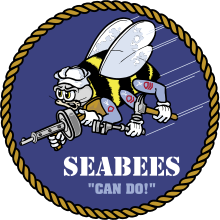Naval Construction Battalion
| Naval Construction Battalions | |
|---|---|

The Seabee logo
|
|
| Active | 5 March 1942 – present |
| Country | United States |
| Branch |
|
| Role | Militarized construction |
| Size |
|
| Nickname(s) | Seabees |
| Motto(s) |
|
United States Naval Construction Battalions, better known as the Seabees, form the Naval Construction Force of the United States Navy. Their nickname is a heterograph of the first initials "C.B." from the words Construction Battalion.
Naval Construction Battalions were conceived of as a replacement for civilian construction companies working for the US Navy after the United States was drawn into World War II with the Japanese attack on Pearl Harbor on 7 December 1941. International law made it illegal for civilians to resist enemy attack, doing so would classify them as guerrillas, for which they could be summarily executed. The Seabees would consist of skilled workers that would be trained to drop their tools if necessary and take up their weapons at a moments notice to defend themselves. The concept model: A USMC–trained Battalion of construction tradesmen (a military equivalent of those civilian Companies) that would be capable of any type of construction, anywhere needed, under any conditions or circumstance. It was quickly realized that this model could be utilized in every theater of operations as it was seen to be flexible and adaptable. The use of USMC organization allowed for smooth co-ordination, integration or interface of both the NCF and Marine Corps elements. In addition, Seabee Battalions could be deployed individually or in multiples as the project scope and scale dictated. What distinguishes Seabees from Combat Engineers are the skill sets. Combat Engineering is but a sub-set in the Seabee toolbox. They have a storied legacy of creative field ingenuity, stretching from Normandy and Okinawa to Iraq and Afghanistan. Admiral King wrote to the Seabees on their second anniversary, “Your ingenuity and fortitude have become a legend in the naval service.” Seabees believe that anything they are tasked with they "Can Do" (the CB motto). They were unique at conception and remain so today. In the October 1944 issue of Flying magazine the Seabees are described as " a phenomenon of world war II ". In 2017, the Seabees celebrate their 75 years of service without having changed from Admiral Ben Moreell's conceptual model.
...
Wikipedia
